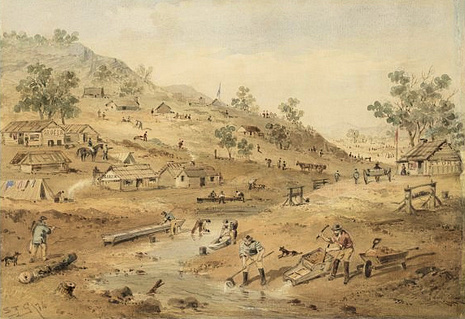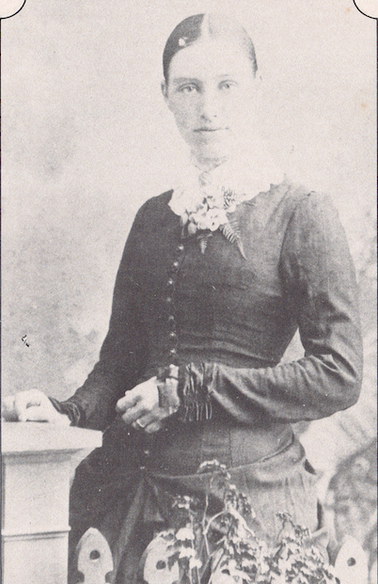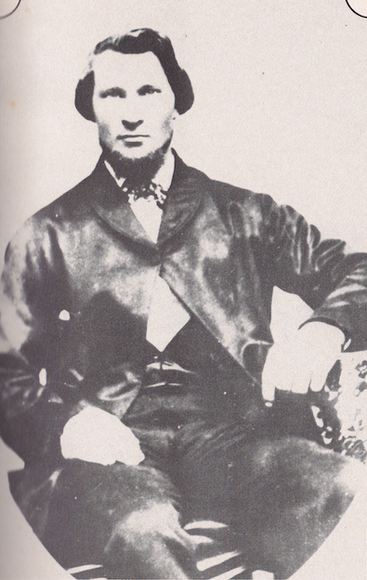claus grønn (1833-1909) - gold digger and brewer
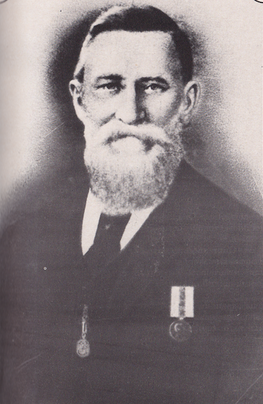
Claus Mathiesen Grønn was one of the early Danish pioneers in Australia, trying his luck in the gold diggings of Castlemaine, Victoria.
After many years in the gold fields, Claus ended up in Melbourne as a brewer.
He led a long life, had a big family, and was well known and respected amongst the Scandinavian communities in Victoria.
Thanks to a diary he kept for most of his life, we have a fantastic account of what life as a Danish pioneer in the late 19th century was like.
After many years in the gold fields, Claus ended up in Melbourne as a brewer.
He led a long life, had a big family, and was well known and respected amongst the Scandinavian communities in Victoria.
Thanks to a diary he kept for most of his life, we have a fantastic account of what life as a Danish pioneer in the late 19th century was like.
Early years in schleswig
Claus was born at Mels in Schleswig in 1833 when it was still part of Denmark. After being sent to sea at the age of 14, he returned two years later and took part in the first Schleswig war between Prussia and Denmark as a cadet in the Danish Marine Service.
Like many other young Danes in the two duchies, he left when the Schleswig-Holstein army was disbanded. Claus spent the next four years at sea sailing to Iceland, Russia, Spain and British Guinea. Now with an adopted anglicised name, Charles Edward Sinclair (which he used until his marriage in 1856 when he resumed his own names), Claus' last voyage was destined for Australia. On June 10, 1854, on board the Koh-i-noor, Claus arrived in Sandridge (now known as Port Melbourne), Victoria and was discharged.
Like many other young Danes in the two duchies, he left when the Schleswig-Holstein army was disbanded. Claus spent the next four years at sea sailing to Iceland, Russia, Spain and British Guinea. Now with an adopted anglicised name, Charles Edward Sinclair (which he used until his marriage in 1856 when he resumed his own names), Claus' last voyage was destined for Australia. On June 10, 1854, on board the Koh-i-noor, Claus arrived in Sandridge (now known as Port Melbourne), Victoria and was discharged.
the life of a gold-digger
|
Following the path of many of his countrymen, Claus decided to try his luck in the goldfields with the hope of earning enough money to be able to return to Denmark with a certain wealth.
After purchasing some basic tools, he trekked 100 km to the gold fields in the Mount Alexander District (Castlemaine). He took board, which cost £1.15s a week and bought a miner's right for £1, leaving Claus with just £5. Conditions in the gold fields were not for the faint-hearted. Digging for gold was hard physical labour, with gold finds few and far between. Dysentery was rife, taking the lives of many including Claus' 'chum' who he had worked with since arriving at Campbell's Creek. |
Claus continued working on his own until one day he had a chance encounter with a fellow Dane, which he described in his diary:
.As I looked up, a man who had plainly been hesitating whether or not to open up a conversation threw me a half-smile as he walked off. He returned in the late afternoon next day. Stopping on the log he raised a hand in salute and said in Danish, 'God aften!'.
'Good afternoon', I replied in my very best English, whereupon, he asked wasn't I a Dane?
Laughing at his disappointed tone, I answered yes in best Danish! When I asked him a few questions in Danish his face lit up and he exclaimed, 'Sure you're a native of Als? That slight dialect!
'You are right', said I, more and more interested. 'I'm from Sonneherred (the South)'. 'And I'm from Norreherred', he returned with that pleasure we always feel to meet someone from our own little corner of the earth. How wonderful to me that this Peter Hansen had actually known my father, the smithy in Mels, and other folk of the village.
The two started working the mine shafts together and became good mates. When Claus became very ill with dysentery, Peter Hansen used his earnings from his own gold finds to pay for Claus' medicine and food. Being unable to work in the diggings for quite some time, Claus was also fortunate to be fluent in English from his years as a seaman and was therefore also able to get by translating for other Danish gold diggers.
Family life
When an area of land was advertised for sale at Sandon, Claus, together with Peter Hansen and another Dane, Peter Skjellerup (both of whom had farming backgrounds), bought 60 acres of land. For a while, Claus continued gold digging whilst the other two started farming. When Claus returned to the farm after a while, it was decided that the two would buy Peter Skjellerup's share.
A 16-year girl from a neighbouring farm, Mary Ann Horsfall, was employed as a 'maid-of-all-work' and her and Claus became close. However, with a disapproving father, Mary Ann and Claus had to elope and got married in 1856. Her father forbade the entire family to have further contact with her.
A 16-year girl from a neighbouring farm, Mary Ann Horsfall, was employed as a 'maid-of-all-work' and her and Claus became close. However, with a disapproving father, Mary Ann and Claus had to elope and got married in 1856. Her father forbade the entire family to have further contact with her.
Soon after, Claus bought out Peter Hansen's share but the farm failed to yield any crops. After two bad years, followed by another when Claus fell ill again, he ended up with a large debt of £730. Even after auctioning off his land, he was still in debt. With the help of friends, he was able to open a small grocery shop in Campbell's Creek and paid off his debts.
The economic burden of a rapidly growing family (Claus and Mary Ann ended up having 20 children), increasing competition from other grocery shops and too many 'credit' customers who did not honour their debts, forced Claus to close up shop and instead return to the mines where he worked till 1868.
The economic burden of a rapidly growing family (Claus and Mary Ann ended up having 20 children), increasing competition from other grocery shops and too many 'credit' customers who did not honour their debts, forced Claus to close up shop and instead return to the mines where he worked till 1868.
The grand old man of the danish diggers
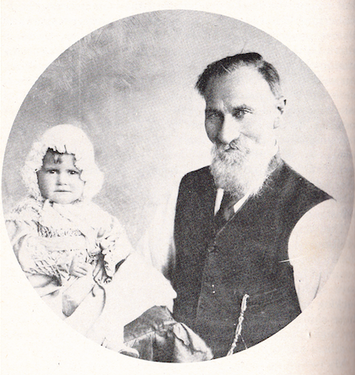 Claus with his grand-daughter, Alma Dagmar Fuller
Claus with his grand-daughter, Alma Dagmar Fuller
Claus then started working at the Crown Brewery where he was promoted to manager. When the owners went bankrupt he had to take up manual labour, putting up fencing along most of the railway between Castlemaine and Guildford, but eventually found employment with another brewery, the Castlemaine Brewery in South Melbourne. Here he was paid five pounds a week, house, land, five cows and wood included.
In 1877, Claus became brewer at the Richmond Cremorne Brewery. During the following almost 20 years, Claus had many jobs in Melbourne, including owning a butcher's shop in Carlton, working at the Ballarat Brewery, he also worked as a money-lender, a window cleaner, and a lamp lighter (until Melbourne changed over to electricity in March 1894).
Claus became quite an identity amongst the Scandinavian communities as the 'grand old man' of the Danish diggers.
In 1877, Claus became brewer at the Richmond Cremorne Brewery. During the following almost 20 years, Claus had many jobs in Melbourne, including owning a butcher's shop in Carlton, working at the Ballarat Brewery, he also worked as a money-lender, a window cleaner, and a lamp lighter (until Melbourne changed over to electricity in March 1894).
Claus became quite an identity amongst the Scandinavian communities as the 'grand old man' of the Danish diggers.
Finally home
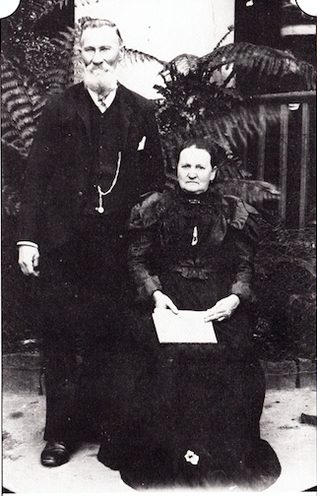 Claus and Mary Ann in retirement
Claus and Mary Ann in retirement
A 42-year-old dream finally came true, when Claus boarded the S.S. Ormuz from Port Melbourne in 1896 to return home for a visit for the first time and to be reunited with surviving members of his family.
Here he was able to visit the grave of his parents in Oksbol Cemetery (and see the headstone which he had paid for). He was also presented with the Service Medal due to him from the 1848-49 War.
Back in Melbourne, Claus later contracted broncho-pneumonia again (which he had also battled during his years on the goldfields), and he passed away 30 September, 1909 aged 77, at his farm "Leavoldston". The farm, north of Oakleigh in the Melbourne suburb of Homesglen, had been the retirement house for Claus and Mary Ann for some years.
Claus was buried at the Burwood Cemetery. Mary Ann, survived her husband by 23 years and lived till 1932 aged 92.
Here he was able to visit the grave of his parents in Oksbol Cemetery (and see the headstone which he had paid for). He was also presented with the Service Medal due to him from the 1848-49 War.
Back in Melbourne, Claus later contracted broncho-pneumonia again (which he had also battled during his years on the goldfields), and he passed away 30 September, 1909 aged 77, at his farm "Leavoldston". The farm, north of Oakleigh in the Melbourne suburb of Homesglen, had been the retirement house for Claus and Mary Ann for some years.
Claus was buried at the Burwood Cemetery. Mary Ann, survived her husband by 23 years and lived till 1932 aged 92.
From the age of 23, Claus kept a diary/account book to record his daily events and expenditures. In his old age, he was then able to compile a book, all written in Danish, for his family detailing his many adventurers as a sailor and a gold-digger and his visits to his home-town of Mels as an old man. 11 copies, one for each of his surviving children, were printed in 1906 by Jens Lyng.
This was later translated and published by Claus' grand-daughter, Cora McDougall, in the book "Gold, Gold! Diary of Claus Gronn, A Dane on the Diggings".
This was later translated and published by Claus' grand-daughter, Cora McDougall, in the book "Gold, Gold! Diary of Claus Gronn, A Dane on the Diggings".
